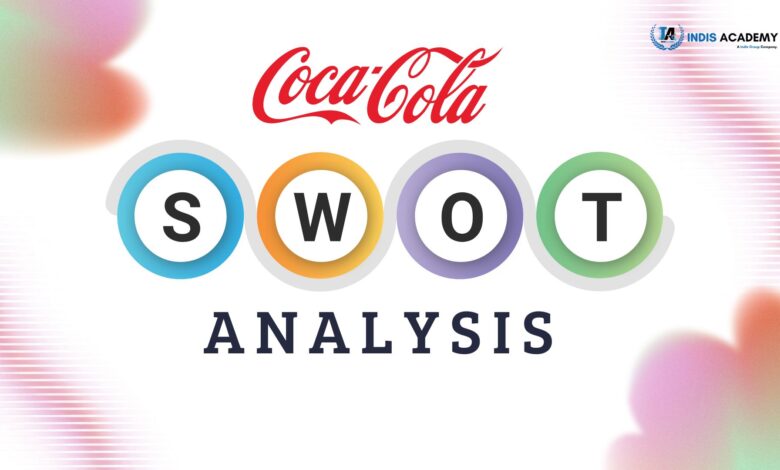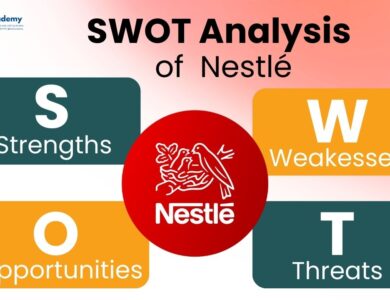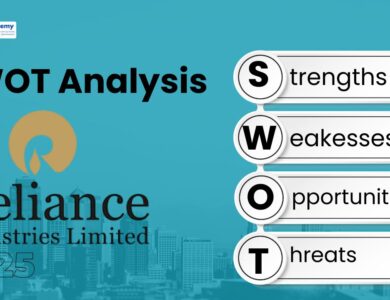SWOT Analysis of Coca-Cola: Inside the Strategy of the Global Beverage Leader
Understand Coca-Cola's global success story with this SWOT analysis, highlighting strategic advantages, potential threats, and innovation in the soft drink sector.

From neighborhood stores in India to vending machines in the U.S., one brand has made its way into nearly every corner of the world—Coca-Cola. Loved for its taste, iconic red branding, and timeless marketing, Coca-Cola isn’t just a beverage company. It’s a global legacy.
But even giants face challenges.
The world is evolving—consumers are becoming more health-conscious, sustainability is a growing concern, and competition is fiercer than ever. So where does Coca-Cola stand today? Is it still ahead of the curve or slowly losing its fizz?
In this blog, we’ll dive deep into the SWOT analysis of Coca-Cola in 2025, exploring its internal strengths and weaknesses, as well as external opportunities and threats. Whether you’re a student, investor, marketer, or brand strategist, this breakdown will give you valuable insights into one of the world’s most iconic brands.
Ready to open the cap on Coca-Cola’s business strategy? Let’s begin with a quick overview of the company.
Also Read: SWOT Analysis of Maggi Noodles: From Instant Fame to Brand Challenges
Learn AI & Digital Marketing,
Pay Fees After Placement
- ✅ Minimal Admission Fees
- ✅ No Loan or Income Sharing Agreement
- ✅ 100% Placement Support
- ✅ ISO & Govt Registered Certificate
- ✅ Practical 3+1 Months Duration
Get a free counseling call. We’ll guide you through learning, certification, and job placement.
Request a Free Call Back
Takes less than a minute.
Company Overview of Coca-Cola
Founded in 1886 by pharmacist Dr. John S. Pemberton, Coca-Cola has evolved from a single soda fountain drink in Atlanta to a global beverage powerhouse.
Today, The Coca-Cola Company operates in 200+ countries, offering a vast portfolio of over 200 brands—ranging from carbonated drinks like Coca-Cola, Fanta, and Sprite to health-oriented options like Smartwater, Minute Maid, and Costa Coffee.
The company doesn’t manufacture all its drinks directly. Instead, it follows a unique franchise bottling model, where it owns the brand and recipe but licenses local bottlers to produce and distribute beverages globally.
As of 2024:
- Headquarters: Atlanta, Georgia, USA
- Annual Revenue: $45+ billion
- Employees: Over 80,000 worldwide
- Key Acquisitions: Costa Coffee, BodyArmor, Honest Tea
Whether you’re grabbing a Coke at a concert or sipping a Dasani on a flight, chances are you’re consuming a Coca-Cola product—without even realizing it.
What is a SWOT Analysis?
Before we break down Coca-Cola’s strategy, let’s first understand what a SWOT analysis really means.
SWOT stands for:
- Strengths – What a company does exceptionally well.
- Weaknesses – Areas where it falls short or faces limitations.
- Opportunities – External trends or openings the brand can capitalize on.
- Threats – Risks or challenges that could impact performance.
For a global brand like Coca-Cola, SWOT helps us uncover why it continues to lead, where it’s vulnerable, and how it must evolve to stay relevant in a rapidly changing world.
Now that we’re clear on the framework, let’s dive into Coca-Cola’s strategic strengths.
Also Read: Lakmé SWOT Breakdown: How the Brand Rules India’s Beauty Market
Strengths of Coca-Cola
Coca-Cola isn’t just a beverage; it’s an experience. The company’s dominance in the global market is backed by solid internal strengths that continue to give it a competitive edge.
Let’s break down the most powerful advantages Coca-Cola holds in 2025:
1. Unmatched Global Brand Recognition
Coca-Cola is one of the most recognized brands on the planet. Its iconic red-and-white logo, signature contour bottle, and memorable ad jingles have built decades of emotional connection with consumers.
It ranks consistently in the top 10 of global brand valuation lists—a symbol of both trust and timeless appeal.
2. Extensive Beverage Portfolio
The company doesn’t just rely on Coke. It owns over 200 beverage brands, including:
-
Carbonated: Coca-Cola, Fanta, Sprite
-
Water: Smartwater, Dasani
-
Juices: Minute Maid, Simply
-
Energy: Monster (via partnership), BodyArmor
-
Coffee & Tea: Costa Coffee, Gold Peak, Honest Tea
This diversified portfolio helps it cater to a variety of tastes and health preferences worldwide.
3. Powerful Distribution Network
Coca-Cola’s global bottling and supply chain system is one of the most sophisticated in the world.
With 24 million+ retail outlets served globally, the company ensures its products are available almost everywhere—from urban supermarkets to small rural kiosks.
4. Marketing & Sponsorship Excellence
From sponsoring the FIFA World Cup to Olympics and Super Bowl ads, Coca-Cola has mastered the art of emotional, high-impact marketing.
Its campaigns often celebrate unity, diversity, and joy, creating deep cultural resonance across geographies.
5. Strong Financial Backbone
Despite market fluctuations, Coca-Cola continues to post strong earnings and dividend returns. Its cash flow allows it to invest heavily in R&D, acquisitions, and sustainability.
In 2024, Coca-Cola reported:
-
Revenue: $46 billion+
-
Operating Margin: 28%+
-
Dividend Yield: 3%+ (making it a favorite among long-term investors)
Competitor Comparison Table
Let’s see how Coca-Cola compares with its closest competitors:
| Company | 2024 Revenue | Global Brands | Core Focus | Market Presence |
|---|---|---|---|---|
| Coca-Cola | $46B+ | 200+ | Beverages only | 200+ countries |
| PepsiCo | $91B+ | 300+ | Beverages + Snacks | 190+ countries |
| Nestlé Beverages | $25B+ | 100+ (in drinks) | Health & packaged drinks | 180+ countries |
Note: PepsiCo has a broader product base due to snacks (Lay’s, Doritos), while Coca-Cola focuses purely on beverages.
These strengths have helped Coca-Cola not only survive industry disruptions but also lead innovation—without losing its classic identity.
Also Read: Complete SWOT Analysis of Jio – A Deep Dive into India’s Telecom Disruptor
Weaknesses of Coca-Cola
Even the most iconic brands have blind spots—and Coca-Cola is no exception. Understanding these internal weaknesses is crucial to assessing its long-term sustainability.
Let’s explore the challenges Coca-Cola needs to overcome:
1. Heavy Dependence on Carbonated Beverages
Despite its vast product lineup, carbonated soft drinks (CSDs) still make up a large portion of Coca-Cola’s revenue. This dependency becomes risky as health-conscious consumers increasingly move away from sugary sodas.
In fact, soda consumption has been declining year-over-year in major markets like the U.S. and Europe.
2. Negative Public Perception Around Health
Coca-Cola has faced years of criticism over its products’ high sugar content, which is linked to obesity, diabetes, and other lifestyle diseases.
This has made it a target of health activists, NGOs, and governments, especially when it comes to advertising to children or sponsoring sports events.
3. Limited Presence in the Healthy Beverage Segment
While Coca-Cola has made moves into bottled water, coffee, and zero-sugar products, it still lags behind in innovation compared to health-focused startups.
Brands offering organic juices, kombucha, plant-based drinks, or functional beverages are rapidly gaining market share—especially among Gen Z and millennials.
4. Environmental Criticism
Plastic pollution is a growing global issue, and Coca-Cola has been repeatedly listed as one of the top plastic polluters worldwide.
Its packaging and water usage practices—especially in developing countries—have drawn regulatory heat and negative media attention.
5. Declining Market Share in Some Regions
In fast-growing markets like India, Southeast Asia, and Latin America, Coca-Cola faces stiff local competition. Smaller, agile beverage brands offering traditional drinks, natural ingredients, or lower prices are starting to grab consumer attention.
In summary, Coca-Cola’s core brand is strong—but these weaknesses show why it can’t rely on legacy alone. Innovation, transparency, and sustainability will be key going forward.
Opportunities for Coca-Cola
The global beverage market is evolving rapidly—and that’s actually good news for Coca-Cola. With its resources and brand value, the company has several exciting opportunities to reinvent and expand.
Let’s explore how Coca-Cola can stay ahead of the curve:
1. Expanding Health-Conscious Product Lines
Consumers are shifting toward low-sugar, zero-calorie, plant-based, and functional drinks. Coca-Cola can accelerate growth by investing in:
-
Sparkling water (e.g., Topo Chico)
-
Probiotic beverages
-
Organic and natural fruit juices
-
Sports and energy drinks with clean labels
Health is no longer a niche—it’s mainstream. This is where Coca-Cola’s next big win could lie.
2. Deeper Market Penetration in Emerging Economies
Markets like India, Indonesia, Nigeria, and Vietnam offer huge growth potential due to their young populations and increasing disposable income.
With customized products (e.g., smaller pack sizes, regional flavors) and localized marketing, Coca-Cola can dominate where it’s currently underpenetrated.
3. Sustainable Packaging & Eco-Friendly Innovations
Environmental sustainability is no longer optional. Coca-Cola has already pledged to collect and recycle a bottle or can for every one it sells by 2030.
Going further with plant-based bottles, reusable packaging, and zero-waste logistics can help win both customer love and regulatory support.
4. Leveraging Acquisitions & Strategic Partnerships
Coca-Cola’s acquisition of Costa Coffee and BodyArmor showed its commitment to product diversification.
Future growth could come from:
-
Buying functional beverage startups
-
Partnering with health tech or lifestyle brands
-
Collaborating with local influencers and delivery apps for brand integration
5. Enhancing Direct-to-Consumer Channels
With more people ordering online, Coca-Cola can build D2C platforms and personalized delivery models. Think subscription-based beverage boxes, exclusive online-only flavors, or corporate wellness tie-ups.
It’s not just about what you sell—but how and where you deliver it.
In short, Coca-Cola is sitting on a mountain of untapped growth—if it embraces innovation, sustainability, and personalization at scale.
Also Read: Complete SWOT Analysis of Hyundai – A Deep Dive into the Korean Auto Giant
Threats to Coca-Cola
Despite its size and legacy, Coca-Cola is not immune to external challenges. In fact, the next few years could be defining for the brand if these threats aren’t tackled head-on.
Let’s break down what Coca-Cola needs to watch out for:
1. Rising Health Awareness and Sugar Taxes
Governments across the world are imposing sugar taxes and stricter regulations on high-calorie beverages. Countries like the UK, Mexico, and India have already started taxing sugary drinks—making them more expensive and less desirable to health-conscious consumers.
This trend directly threatens Coca-Cola’s core soda business.
2. Intensifying Competition from Local and Global Brands
Coca-Cola no longer competes with just Pepsi. It faces threats from:
-
Local beverage brands offering traditional drinks and natural flavors
-
Startups focused on kombucha, cold-pressed juices, and plant-based drinks
-
Global players like Nestlé and Red Bull expanding aggressively
Consumers now have more options than ever, many of which align better with evolving health and environmental values.
3. Environmental Pressure and Climate Risk
Being one of the world’s largest beverage companies means Coca-Cola uses massive amounts of water and plastic—drawing criticism from environmental groups and activists.
Climate change also threatens the availability and cost of key resources like water, sugar, and fruit pulp—potentially impacting operations and pricing.
4. Supply Chain Disruptions
The COVID-19 pandemic highlighted the fragility of global supply chains. From bottling plants to distribution networks, any disruption can hurt Coca-Cola’s ability to maintain its “always available” promise.
Geopolitical tensions, shipping costs, and raw material inflation could all impact profitability.
5. Shifting Consumer Behavior
Today’s consumers expect more than just a drink—they want transparency, ethics, and purpose. Gen Z, in particular, favors brands that stand for social change and sustainability.
If Coca-Cola fails to align its brand messaging with these values, it risks becoming outdated or irrelevant in key markets.
These threats make it clear: Coca-Cola’s future success lies not just in its legacy—but in its ability to evolve rapidly and responsibly.
Strategic Insights & Key Takeaways
Coca-Cola’s story is a masterclass in global branding—but maintaining leadership in 2025 demands more than just a strong past.
Here’s what stands out from the SWOT analysis:
-
Coca-Cola’s brand recognition and global reach remain unmatched. This gives it a powerful foundation to scale any new product or campaign.
-
Its dependence on sugary sodas is a double-edged sword. While it’s a revenue driver, the health-conscious wave is too big to ignore.
-
The company has real momentum in expanding through acquisitions (like Costa and BodyArmor) and growing health-focused portfolios.
-
However, regulatory, environmental, and cultural shifts are reshaping what consumers want—and Coca-Cola must adapt faster.
To stay ahead, Coca-Cola needs to:
-
Push harder into zero-calorie, organic, and functional beverage segments
-
Invest in sustainable packaging and reduce its carbon footprint
-
Embrace digital-first experiences and direct-to-consumer models
-
Rethink its marketing to connect with next-gen, purpose-driven consumers
In short: Coca-Cola has all the tools to lead the beverage world again—but only if it evolves as fast as the world around it.
Conclusion
Coca-Cola is more than just a beverage—it’s a symbol of global culture. For over a century, it has stood as a leader in branding, taste, and consumer trust.
But the world is changing. Health concerns, environmental demands, and shifting consumer behaviors are redefining what people expect from the brands they love.
The SWOT analysis of Coca-Cola shows that while the company has undeniable strengths—brand loyalty, reach, and financial stability—it also faces significant challenges. Its ability to innovate beyond sugary sodas, embrace sustainability, and stay culturally relevant will determine how strong its fizz remains in the future.
In the end, Coca-Cola’s success won’t just depend on its past—but on how well it listens, adapts, and evolves with its audience.
FAQs – Coca-Cola SWOT Analysis
1. What are Coca-Cola’s biggest strengths?
Coca-Cola’s biggest strengths include unmatched global brand recognition, a wide product portfolio, a powerful distribution network, and highly effective marketing campaigns.
2. Why is Coca-Cola criticized?
Coca-Cola is often criticized for its high sugar content, contributing to health issues, excessive use of plastic packaging, and significant water consumption in some regions.
3. What are the key opportunities for Coca-Cola?
Key opportunities include expanding into health-conscious beverages, investing in sustainable packaging, growing in emerging markets, and acquiring innovative drink startups.
4. What threatens Coca-Cola’s future growth?
Major threats include sugar taxes, health awareness, intense competition from local and health-focused brands, environmental regulations, and shifting consumer behavior.





